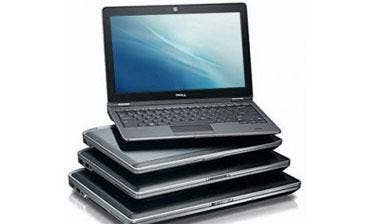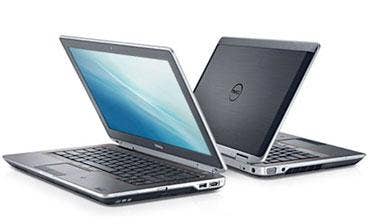Notebook Face-Off: Dell Latitude E6520 Vs. Dell Latitude E6320

What's the difference between Dell's Latitude E6320 and Latitude E6520 models? Aside from screen size and price, there's plenty that sets these machines apart, and knowing the differences could make or break a laptop deal. Dell sent the CRN Test Center one each of these rugged and powerful laptops, and we were more than happy to compare laptops.
Before we describe how these machines differ, it's helpful first to list the things they have in common. These are the high-end models of Dell's latest series of Sandybridge-based laptops unveiled in February. Both tested machines are equipped with Intel Core i7 vPro (2620M) processors running at 2.70 Ghz with 4MB cache and Intel's HD Graphics 3000 on-processor display. Both were running Windows 7 Professional 64-bit on 4 GB of 1333 MHz DDR3 SDRAM. Two memory slots each can accept a maximum DIMM size of 4GB.
As for media, both machines offer a front-loading SD card reader, an optical media slot on the right-hand side in a slot that also can alternatively accept an extra three-cell battery or hard drive. The right edge is also home on both machines to a USB 2.0 port and an eSata/USB 2.0 combo port. Both the E6320 and the E6520 provide ExpressCard slots here too, but the E6320 slot is the smaller 34-mm slot, while the E6520's is the full-sized 54-mm form factor, and accepts those L-shaped cards. There's also an "airplane" (wireless shut-off) switch on both models, positioned just above the DVD drawer. The E6520 adds an HDMI port here; on the E6320, there's a Mini-HDMI port around the corner (Mini-HDMI adapters are optional). The one port that the E6520 offers uniquely is a 1394 FireWire, located on the right edge.
As is typical of Dell laptops these days, the battery hangs off the back edge of the unit. We don't mind this at all as a means of adding cells, and it also helps protect Dell's straight-line power connectors, which protrude rearward nearly two inches before the cable starts to bend. Again, we'll renew our call for laptop makers either to bite the bullet and license Apple's MagSafe technology, or invent their own in a clean-room somewhere. Really folks, this vulnerability is ridiculous already.
The E6320 comes with a six-cell Lithium Ion battery and 65-watt AC adapter; the E6520 includes a nine-cell Lithium Ion battery and 90-watt AC adapter. Although these batteries are the same width, they are not interchangeable. Dell also offers an optional 90-watt AC adapter for the E6320 and three-, six-, and nine-cell battery options for both machines, including a "slice" battery that attaches to the bottom and keeps the same footprint. Alas, Dell didn't send one for testing. The rear edge also is home on both machines to the RJ-45 for Gigabit Ethernet and Kensington Security Slot. The E6520 puts another USB 2.0 here as well as the RJ-11 port if the optional modem is present.
Next: The Bottom Line

On both machines, the left-hand edge is home to a VGA connector, headset jack, SmartCard reader slot and access to the 2.5-inch hard drive which is secured with four screws. The E6520 adds a USB 2.0 port. We like Dell's use of the combined headphone/microphone jack for its cleaner look elimination of plugging mistakes. Making our way back to the the front edge, we notice that the E6520 requires a lid latch while the E6320 uses springs to stay closed. Either way is fine with us, as long as the lid latch can be operated with one hand.
Once inside, we notice a good many other identical characteristics. Both machines are equipped with a trackpad and a finger-tip pointing device, and each has its own set of buttons. The 6530's trackpad is about a quarter-inch higher than the E6320's; both are 3.25-inches wide. Both units also provide dedicated buttons for volume control and mute, a feature we always look for and favor very much. Also common are power switch and LEDs for wireless and hard drive access and battery status. The upper display bezel is home on both units to an HD web cam and mic. The 15-inch wide E6520 uses the extra two inches it has over its smaller cousin for a numerical keypad.
Between the Latitude E6520 and Latitude E6320, performance too was essentially identical. With Windows 7 settings configured to provide maximum performance, the E6320 delivered a high Geekbench 2.1.13 score of 7647, and the E6520 a high score of 7633. Statistically identical to each other, these scores are significantly higher--by 1000 to 1500 points--than scores of similarly equipped machines from other vendors.
The Bottom Line
Both the Latitude E6520 and Latitude E6320 are well-performing machines wrapped in rugged magnesium casing and equipped with Dell's motherboard-based Free Fall Sensor technology protecting hard drive data. The Latitude E6520 offers a 15.6-inch screen (vs. 13.3-inch) with native resolution up to 1920 x 1080 (vs. 1366 x 768) with optional multi-touch (vs. none) driven by an optional NVidia NVS 4200M discrete graphics adapter (vs. none). The higher-end machine also delivers four USB 2.0 ports (vs. two), a 54mm ExpressCard slot (vs. 34mm) and FireWire 1394 (vs. none). Both include dock connectors.
The 15x10-inch E6520 weighs 7.5 pounds with the AC adapter; the 13x9-inch E6320 tips the scale at 5.5 pounds. They're both about 1.25 inches thick. Starting price for the Latitude E6520 is $1090; as tested it lists for $1925. The Latitude E6320 starts at $959; as tested its list price is $2086. Both ship with a three-year basic hardware service warranty, and both are recommended products by the CRN Test Center.